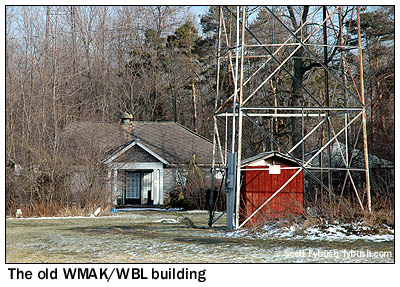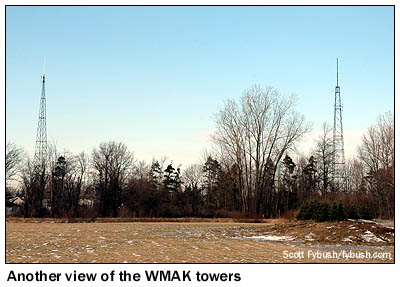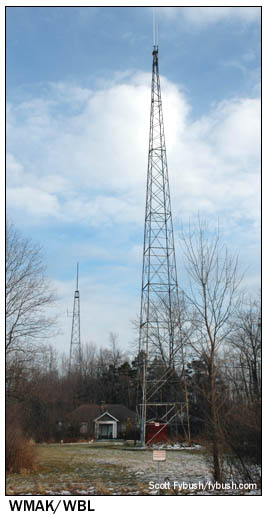
|
|

February 15, 2008
WMAK (WBL), North Tonawanda, NY
 |
 |
Every once in a while, an interesting piece of broadcast history will be found sitting in plain sight - and every once in a very long while, that interesting piece of broadcast history is just an hour or so away from our home base here in western New York.
We credit Jim Travis, chief engineer for the Family Life Network, for unearthing this week's featured site, which hasn't seen broadcast use since at least 1940.
 Jim
drove by this site at 7263 Shawnee Road in North Tonawanda, north
of Buffalo (actually, it's just over the line in the town of
Wheatfield), a month or so ago and wondered what these two self-supporting
towers were doing in an area that's rapidly being developed into
residential subdivisions. He asked former upstate engineer (and
broadcast engineer) Mark Humphrey, who began to uncover the fascinating
history behind these towers and the building that sits between
them.
Jim
drove by this site at 7263 Shawnee Road in North Tonawanda, north
of Buffalo (actually, it's just over the line in the town of
Wheatfield), a month or so ago and wondered what these two self-supporting
towers were doing in an area that's rapidly being developed into
residential subdivisions. He asked former upstate engineer (and
broadcast engineer) Mark Humphrey, who began to uncover the fascinating
history behind these towers and the building that sits between
them.
What Mark found first was a website describing the history of marine shortwave/VHF station WBL, which operated from out here on Shawnee Road from the early 1940s until sometime in the early eighties, first under RCA ownership and later in private hands. (It turns out that one of the operators at WBL in the seventies was Dan Gurzynski, who'd later go on to be an engineer at the Entercom stations in Buffalo.)
But before these towers belonged to WBL, they served as the transmitter site for one of the Buffalo area's first radio stations. WMAK came on the air in Lockport, 10 miles north of this site, in 1922. It soon moved from little Lockport to much bigger Buffalo, where engineer I.R. "Ike" Lounsberry set up studios in the Hotel Lafayette, making WMAK (by then a charter CBS affiliate) the first of several broadcasters who would call that building home.
In 1927, Lounsberry moved WMAK's transmitter from the Norton Laboratories on Mill Street in Lockport to this Shawnee Road location, erecting these towers and the building between them. By then, WMAK had settled down on 900 kilocycles, a frequency that had also been used at one point by another station in which Lounsberry would have an interest, WGR.
For a few years, WMAK was part of Lounsberry's Buffalo Broadcasting Corp., which briefly held a monopoly on the city's radio scene, also operating WGR, WKBW and WKEN.
The monopoly didn't last, though - WMAK went dark in 1930, and was sold to the Buffalo Evening News, which returned it to the air September 8, 1930 under new calls, WBEN. For WBEN's first decade, its 1000-watt signal came from the longwire antenna strung between these towers. In 1940, WBEN built its new 5000-watt site seven miles or so to the southwest (and closer to Buffalo) on Grand Island, a site we featured here on Site of the Week last summer.
And something strange happened along the way: as WBEN became one of the mainstays of Buffalo broadcasting, it quietly buried its WMAK past. Maybe it was WMAK's connection to the two stations that became WBEN's biggest competitors, WGR and WKBW. Maybe it was an attempt to avoid associating big-city WBEN with WMAK's small-town beginnings up in Lockport. In any event, WBEN would list "1930" as its sign-on date for many decades thereafter, and in recent years even its own engineer wasn't sure where the transmitter had been before Grand Island.
But history can't stay buried forever, at least not when it's still visible in the form of two big self-supporting towers on a busy highway. Even this site's later incarnation as WBL is gone now, with the old building boarded up and silent. Perhaps someday it can be revived as a museum, telling some of the stories of Buffalo radio in days gone by. And in the meantime, it joins our list of some of the oldest broadcast sites still standing, anywhere in the country.
Tower Site Calendar 2008 is here! Visit the Fybush.com Store now and get your calendar now!
- Previous Site of the Week: From Downtown Milwaukee to Watertown, via WSSP/WMYX
- Next Week: WOLX 94.9, Baraboo/Madison
- Site of the Week INDEX!
- How can you help support Site of the Week? Click here!
- Submit your suggestions for a future Site of the Week!
